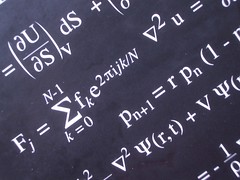 |
K. Grabowska, Moreno and myself have placed a preprint on the arXiv called ‘On a geometric framework for Lagrangian supermechanics‘. |
In this work we take the notion of a curve on a supermanifold to be an S-curve, which is an ‘element’ of the mapping supermanifold Hom(R,M) [1]. This mapping supermanifold is a generalised supermanifold and so it is a functor from the (opposite) category of supermanifolds to sets. Each ‘element’ needs to be ‘probed’ by a supermanifold, and so S-curves are ‘curves’ that are parameterised by all supermanifolds. Or maybe better to say that an S-curve is a family of functors paramaterised by time. At any given time and a given supermanifold S, we have a morphism of supermanifolds S → M. That is, an S-curve tracks out the S-points of M.
With this robust notion of a curve, we go on to define what we mean by an autonomous ordinary differential equation on a supermaifold, and more importantly what we mean by a solution. This seems to have been a notion not at all clearly defined in the existing literature. For us, a differential equation is a sub-structure of the tangent bundle of the said supermanifold, and solutions are S-curves on the supermanifold for which their tangent prolongation sit inside the differential equation. This is very close to the classical notions, but now we use S-points and not just the topological points.
We then take these notion and apply them to supermechanical systems given in terms of a Lagrangian. We use Tulczyjew’s geometric approach to Lagrangian mechanics, and really we only modify the notion of a curve and not the underlying geometry of Tulczyjew’s approach [2]. In doing so, we have a well defined notion of the phase dynamics, the Euler-Lagrange equations and solutions thereof for mechanical systems on supermanifolds. We present a few nice example, includinh Witten’s N=2 supersymmetric model [3] and geodesics on a super-sphere.
The importance of this work is not so much in the equations we present, these can be derived using formal variations. The point is we give some proper mathematical understanding of solutions to the equations.
References
[1] Andrew James Bruce, On curves and jets of curves on supermanifolds, Archivum Mathematicum, vol. 50 (2014), issue 2, pp. 115-130.
[2] W. M. Tulczyjew, The Legendre transformation, Ann. Inst. H. Poincare Sect. A (N.S.), 27(1):101–114, 1977.
[3] Edward Witten, Dynamical Breaking of Supersymmetry, Nucl. Phys. , B188:513, 1981.